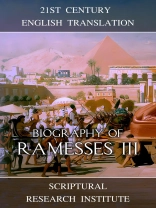Ramesses III was the king of Egypt between circa 1186 and 1155 BC, after inheriting the throne from his father Setnakhte, the founder of the 20th Dynasty. Setnakhte had seized power after the previous Pharaoh Queen Twosret died at the end of the 19th dynasty. It is unclear if he was descended from the royal family, however, he refused to recognize the kingship of either Twosret or her predecessor Siptah, implying he was a descendant of Seti II, the last Pharaoh whose rule he recognized. Seti II had only reigned for about 6 years when he died, while Siptah and Twosret only ruled for a total of 8 years. Before their rule, Egypt had been ripped apart by the civil war between Seti II and Amenmesse, which brought chaos to the land that had not been resolved until Setnakhte’s short, three-year reign. The Biography of Ramesses III reports that a Syrian named Arsu seized control of the land, which would have happened sometime during the reigns of Siptah or Twosret, between 1197 and 1189 BC. This Syrian invasion happened shortly after the previous uprising across Canaan in 1206 BC, suggesting that the Egyptians never really managed to regain control over the area.
According to the Biography of Ramesses III, Setnakhte reunited the land of Egypt, and then Ramesses III restored the earlier prestige of Egypt, conquering all Egypt’s enemies, and reopening trade with Punt. While Setnakhte is considered the founder of the 20th dynasty, Ramesses III is considered the founder of the Ramesside Period, the last great era of Egyptian history, in which the restored Egyptian Empire of Ramesses III slowly lost power over the final century of the New Kingdom era, and finally collapsed. The Biography of Ramesses III claims that he defeated the Palestinians and Tjeker of southern Canaan, Libyans of the Saharan Oases, and the Sardinians and Greeks in their isles. While there is no evidence of the Egyptians invading Greece or Sardinia, Sardinian artifacts including weapons have been found in Crete, the Greek mainland, Cyprus, and Sicily, supporting the reports in the Egyptian records that they were in an alliance at the time. Pylos, in southwestern Peloponnese, was destroyed by someone circa 1180 BC after the land was suddenly attacked by a major force. The records found at the site mention defenses being quickly erected that clearly weren’t strong enough to defend the city. In the mid-1100s, many sites across Greece were destroyed, and much of the population of Boeotia, Argolis, and Messenia disappeared, supporting the claims that the Egyptians took many of them as captives after the battles.
The Biography of Ramesses III is preserved in the longest known papyrus scroll to survive to the present, the 41 meter-long (134.5 foot-long) Papyrus British Museum EA 9999 scroll. The scroll includes 1500 lines of text, mostly lists of gifts that Ramesses III made to the various temples, however, the so-called ‘Historical Section’ at the end, includes his biography, which is not of the longer and more elaborate biographies from any dynasty to survive to the present. The biography was written at the beginning of Ramesses IV’s rule after Ramesses III died, as reported at the end of the biography.
Scriptural Research Institute
Biography of Ramesses III [EPUB ebook]
Biography of Ramesses III [EPUB ebook]
ซื้อ eBook เล่มนี้และรับฟรีอีก 1 เล่ม!
ภาษา อังกฤษ ● รูป EPUB ● ISBN 9781989852828 ● ขนาดไฟล์ 3.0 MB ● สำนักพิมพ์ Digital Ink Productions ● การตีพิมพ์ 2025 ● ที่สามารถดาวน์โหลดได้ 24 เดือน ● เงินตรา EUR ● ID 9205150 ● ป้องกันการคัดลอก ไม่มี












